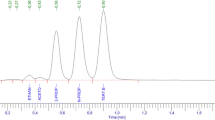Abstract
The hydrolysis of vinyl acetate (formation of acetic acid) has been studied in vitro with rat liver and lung microsomes, rat and human plasma and purified esterases (such as acetylcholine esterase, butyrylcholine esterase, carboxyl esterase). Characterization of the kinetic parameters revealed that rat liver microsomes and purified carboxyl esterase (from porcine liver) displayed the highest activity.
In order to establish the rate of metabolism of vinyl acetate in vivo, rats were exposed in closed desiccator jar chambers, and gas uptake kinetics were studied. The decay of vinyl acetate was dose-dependent, indicating possible saturation of metabolic pathway(s). The maximal clearance (at lower concentrations) of vinyl acetate from the system (30 000 ml/h per kg body weight) was similar to the maximal ventilation rate in this species. This indicated that under conditions when metabolic enzymes are not saturated the metabolic rate is mainly determined by pulmonary uptake.
The exposure of rats to vinyl acetate resulted in a transient exhalation of significant amounts of acetaldehyde into the closed exposure system. This indicates the presence of this metabolic intermediate of vinyl acetate in the organism in vivo.
Similar content being viewed by others
References
Arndt R (1973) Isolierung und Charakterisierung von CarboxylEsterasen (E.C. 3.1.1.1) der Rattenleber, Diss., Kiel
Bolt HM, Filser JG, Buchter A (1981) Inhalation pharmacokinetics based on gas uptake studies. III. A pharmacokinetic assessment in man of “peak concentrations” of vinyl chloride. Arch Toxicol 48: 213–228
Bolt HM, Laib RJ, Filser JG (1982) Reactive metabolites and carcinogenicity of halogenated ethylenes. Biochem Pharmacol 31: 1–4
Bolt HM, Filser JG, Stornier F (1984) Inhalation pharmacokinetics based on gas uptake studies. V. Comparative pharmacokinetics of ethylene and 1,3-butadiene in rats. Arch Toxicol 55: 213–218
Deutsche Forschungsgemeinschaft (1983): Vinylacetat. In: Henschler D (ed) Gesundheitsschädliche Arbeitsstoffe, toxikologisch-arbeitsmedizinische Begründungen von MAKWerten 9. Lieferung. Verlag Chemie, Weinheim
Filser JG (1985) Habilitationsschrift, FB Medizin, Johannes-Gutenberg-Universität Mainz.
Filser JG, Bolt HM (1979) Pharmacokinetics of halogenated ethylenes in the rat. Arch Toxicol 42: 123–136
Filser JG, Bolt HM (1981) Inhalation pharmacokinetics based on gas uptake studies. I. Improvement of kinetic models. Arch Toxicol 47: 279–292
Filser JG, Bolt HM (1983) Inhalation pharmacokinetics based on gas uptake studies. IV. The endogenous production of volatile compounds. Arch Toxicol 52: 123–133
Guyton AC (1947) Respiratory volumes of laboratory animals. Am J Physiol 150: 70–77
Jones RB, Mackrodt WC (1983) Structure-genotoxicity relationship for aliphatic epoxides. Biochem Pharmacol 32: 2359–2362
Lijinski W, Reuber MD (1983) Chronic toxicity studies of vinyl acetate in Fischer rats. Toxicol Appl Pharmacol 63: 43–53
Maltoni C (1977) Vinyl chloride carcinogenicity: an experimental model for carcinogenesis studies. In: Hiatt AM, Watson JD, Winsten JA (eds) The Origins of Cancer, vol A. Cold Spring Harbor Labarotory, New York, pp 119–164
Mentlein R, Heymann E (1984) Hydrolysis of esterand amidetype drugs by the purified isoenzymes of nonspecific carboxylesterase from rat liver. Biochem Pharmacol 8: 1243–1248
Norppa H, Tursi F, Mäki-Paakanen J, Järventaus J, Sorsa M (1983) Vinylacetate is a potent inducer of chromosome damage in mammalian cells. International seminar on methods of monitoring human exposure to carcinogenic and mutagenic agents. Espoo, Finland, IARC Scientific Publications (in press)
Remmer H, Greim H, Schenkman JB, Estabrook RW (1967) Methods for the evaluation of hepatic mixed-function oxidase levels and cytochrome P-450. Methods Enzymol 10: 703–708
Siegers CP, Filser JG, Bolt HM (1978) Effect of dithiocarb on metabolism and covalent binding of carbon tetrachloride. Toxicol Appl Pharmacol 46: 709–716
Author information
Authors and Affiliations
Rights and permissions
About this article
Cite this article
Simon, P., Filser, J.G. & Bolt, H.M. Metabolism and pharmacokinetics of vinyl acetate. Arch Toxicol 57, 191–195 (1985). https://doi.org/10.1007/BF00290886
Received:
Accepted:
Issue Date:
DOI: https://doi.org/10.1007/BF00290886




